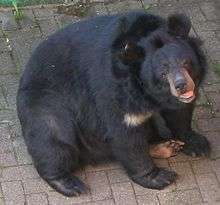Wildlife of Afghanistan
Afghanistan has long been known for its rich and diverse wildlife, as recorded in Baburnama (Persian for "Memoirs of Babur"). Tigers and cheetahs have been present in lowland parts of Afghanistan until the mid-twentieth century.
For majority of the Afghan people, natural resources are the source of their livelihood and the basis of their existence. “Virtually the entire land surface of Afghanistan has been used for centuries – whether for local farming or, on a more wide-reaching basis, for livestockgrazing, fuelwood collection and hunting”, says Pekka Haavisto, Chairman of the Afghanistan Task Force of the United Nations Environment Programme (UNEP) and former Finnish Minister for Environment. In 2003, a Post-Conflict Environment Assessment Report revealed how warfare in the country had degraded the environment. The report partly also focused on the dramatic decrease of wildlife due to poaching, and outlines ways to respond to these threats.
Many of the larger mammals in the country are categorized by the International Union for Conservation of Nature (IUCN) as globally threatened. These include the snow leopard, Marco Polo sheep, Siberian musk deer, markhor, urial, and the Asiatic black bear. Other species of interest are the ibex, the gray wolf, and the brown bear, striped hyenas, and numerous bird of prey species. Most of the Marco Polo sheep and ibex are being poached for food, whereas wolves, snow leopards and bears are being killed for damage prevention.[1]
The fur, however, is being sold to aid workers and foreign soldiers as souvenirs on local markets.
With five million returning ex-patriots between 2002 and 2014, the pressure on Afghanistan's natural resources are set to increase further. The UNEP Report makes it clear that environmental restoration must play a major part in the reconstruction efforts in Afghanistan.
In 2011, camera traps captured a photo of a Persian leopard, a big cat previously thought to be extinct. With its nine species of wild cats, Afghanistan is second only to Sub-Saharan Africa in big cat diversity. There is the desert in western Herat, where cheetahs are said to exist, and eastern Ghazni province, which may contain the highest breeding colony of flamingos in the world.[2]
Sampling Afghanistan's wildlife
- Altai weasel (Mustela altaica)
- Asiatic black bear (Ursus thibetanus)
- Asiatic brown bear (Ursus arctos)
- Caracal (Caracal caracal)
- Eurasian otter (Lutra lutra)
- Geoffroy's bat (Myotis emarginatus)
- Gray wolf (Canis lupus)
- Hare (Lepus tolai)
- Ibex (Capra sibirica)
- Kashmir cave bat (Myotis longipes)
- Leopard (Panthera pardus)
- Lesser horseshoe bat (Rhinolophus hipposideros)
- Long-tailed marmot (Marmota caudata)
- Lynx (Lynx lynx)
- Marco Polo sheep (Ovis ammon polii)
- Markhor (Capra falconeri)
- Mehely's horseshoe bat (Rhinolophus mehelyi)
- Mouflon (or urial) (Ovis orientalis)
- Pallas’ cat (Otocolobus manul)
- Pikas (Ochotona spp)
- Red fox (Vulpes vulpes)
- Sind bat (Eptesicus nasutus)
- Snow leopard (Uncia uncia)
- Stoat (Mustela erminea)
- Stone marten (Martes foina)
- Wild goat (Capra aegagrus)
- Zarudny's jird (Meriones zarudnyi)
See also
References
- ↑ Adventures in conservation: protecting wildlife in Afghanistan: An interview with Dr. Alex Dehgan, Afghanistan Country Director for the Wildlife Conservation Society; Rhett A. Butler, mongabay.com; August 7, 2007
- ↑ http://www.usatoday.com/news/world/afghanistan/story/2012-05-27/Afghanistan-tourism-limited-by-war/55237330/1
External links
| Wikimedia Commons has media related to Wildlife of Afghanistan. |
- Fanged deer spotted in Afghanistan, first sighting in 60 years
- Elusive snow leopards discovered in remote corner of Afghanistan
| ||||||||||||||
Afghanistan CMF
